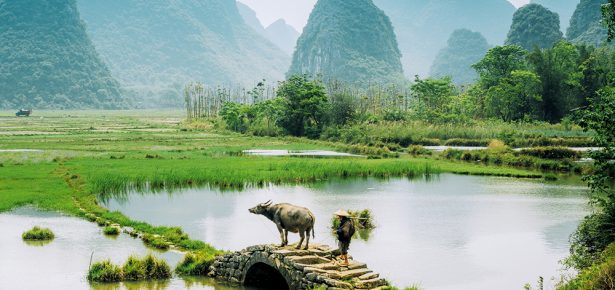
Dealing with a warming world and providing enough food for a growing planet (and doing so in a sustainable fashion that is adapted to changing climate) is one of the key challenges humanity must face in coming decades. But what if some of the greatest resources for helping us deal with global warming already existed in plain sight?
Asia is one of the most densely populated areas of the world, with roughly 60% of the world’s population, most of whom are engaged in agricultural production systems which have historically been some of the most productive on the planet. Asian farming systems have adapted to changes in an annual cycle of rainfall and changing temperatures known as the Asian monsoon. Although rainfall in South Asia may continue to be strong, we demonstrate how crops may still be harmed if high temperatures result in more evaporation and drier soils. Moreover, some of the extra rainfall may fall in the form of destructive storms rather than in more gradual rainfall that is more amenable to agricultural production. Reduction in summer monsoon rains is particularly acute in North China where predicted changes over the rest of the 21st century imply significant challenges to farming.
What if the crops and systems of cultivation that hold the solution to changing climate already exist? Enter archaeology. Over the course of the past 11,000 years farmers across Asia have developed types of crops and cultivation systems that have allowed them to be resilient to past climate change. We argue that this wide range of strategies may prove to be our greatest asset as we face ongoing and future climatic change.
We use the past as a guide to the future to argue that it is these traditional methods of cultivation that might provide humanity’s best assets for confronting the uncertainties of climate change. In the recent past, agricultural reforms, such as the Green Revolution in South Asia and the Great Leap Forward in China, largely ignored the expertise accumulated by Asian farmers over the centuries and resulted in setbacks for production. Over the past 8000 years farming systems have been resilient to changes in rainfall because of their reliance on water from rivers. We review how farmers flexibly managed the cultivation of dryland crops like wheat, barley and millets in the face of changing rainfall and temperatures. We find that in some farming systems, like those of the Indus Valley Civilization, when conditions became too dry, people shifted cultivation towards arid tolerant crops like millet. In other regions, such as on the Tibetan plateau, a cold and dry climate event 4000 years ago made it impossible for farmers to continue to cultivating heat loving millets, and shifted their production to cold adapted crops like barley.
While these are well known to archaeologists some of the crops are not well known to the public. Yet these crops require very little water for their cultivation, are heat tolerant and may provide important adaptions for future global warming. Sadly, both the biodiversity of these crops as well as the knowledge of past cultivation systems are threatened by agricultural practices that have been imposed in the area.
Latest Comments
Have your say!